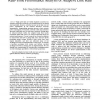Free Online Productivity Tools
i2Speak
i2Symbol
i2OCR
iTex2Img
iWeb2Print
iWeb2Shot
i2Type
iPdf2Split
iPdf2Merge
i2Bopomofo
i2Arabic
i2Style
i2Image
i2PDF
iLatex2Rtf
Sci2ools
LCN
2008
IEEE
2008
IEEE
Real-time performance analysis of Adaptive Link Rate
—High speed links are widely deployed in modern day computer networks to meet the ever growing needs for increasing data bandwidth. However, with the increase in the link rate, the power consumption of the network interfaces increases exponentially, compounding growing concerns about network power consumption. Fortunately, network traffic characteristics show that rapid link rates are not always required. During times of reduced network traffic, the Adaptive Link Rate (ALR) mechanism allows link rates to be reduced with little impact on network performance. Current research has focused on policies to control when and how to change link rates, and have shown promising energy savings. However, these works have been largely simulative, and have not addressed many of the challenges involved in implementation. In this paper, we develop a hardware prototype ALR system and address real-time challenges involved in realizing such an implementation. We also identify new considerations for cont...
| Added | 31 May 2010 |
| Updated | 31 May 2010 |
| Type | Conference |
| Year | 2008 |
| Where | LCN |
| Authors | Baoke Zhang, Karthik Sabhanatarajan, Ann Gordon-Ross, Alan D. George |
Comments (0)

